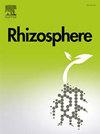盐胁迫对野生大豆根际真菌群落的影响
IF 3.5
3区 生物学
Q1 PLANT SCIENCES
引用次数: 0
摘要
野生大豆(Glycine soja);作为我国二级保护野生植物,祖柏(Zucc)对盐胁迫的响应机制具有重要的研究价值。鉴于黄河三角洲是中国仅存的大型野生大豆原生栖息地,该地区严重的土壤盐碱化严重抑制了根的生长。采用盐梯度水培试验和高通量测序技术,分析了盐胁迫对野生大豆根/根际真菌群落的影响。我们的目的是阐明盐胁迫下植物-真菌相互作用的重组,并利用有益的根/根际真菌来提高盐碱土壤中稀有糖植物(如野生大豆)的非生物胁迫耐受性。主要研究结果表明,尽管根相关真菌群落(根和根际)在不同盐度水平下的生物多样性指数没有显著差异,但它们通过结构重塑激活了适应性调节途径。具体来说,Mortierella真菌属的富集增强了植物在逆境条件下的抗逆性。这一发现为了解稀有糖叶植物的盐适应机制提供了新的思路,为保护濒危植物和开发盐碱地生态系统中的微生物资源奠定了理论基础。本文章由计算机程序翻译,如有差异,请以英文原文为准。
Effects of salt stress on root and rhizosphere fungal communities of wild soybean
Wild Soybean (Glycine soja Siebold & Zucc), a Chinese Class II Protected Wild Plant Species, exhibits significant research value regarding its salt stress response mechanisms. Given that the Yellow River Delta represents China's sole remaining large-scale native habitat for Wild Soybean, severe soil salinization in this region substantially inhibits root growth. This study employed hydroponic experiments with salt gradients and high-throughput sequencing to analyze salt stress effects on root/rhizosphere fungal communities in Wild Soybean. We aimed to elucidate plant-fungal interaction restructuring under salinity and harness beneficial root/rhizosphere fungi to enhance abiotic stress tolerance in rare glycophytes (e.g., Wild Soybean) within saline-alkali soils. Key findings reveal that although root-associated fungal communities (root and rhizosphere) did not exhibit significant differences in biodiversity indices across salinity levels, they activated adaptive regulatory pathways through structural remodeling. Specifically, enrichment of the stress-mitigating fungal genus Mortierella enhanced plant resilience under adverse conditions. This discovery provides novel insights into salt adaptation mechanisms of rare glycophytes and establishes a theoretical foundation for conserving endangered plants and developing microbial resources in saline ecosystems.
求助全文
通过发布文献求助,成功后即可免费获取论文全文。
去求助
来源期刊

Rhizosphere
Agricultural and Biological Sciences-Agronomy and Crop Science
CiteScore
5.70
自引率
8.10%
发文量
155
审稿时长
29 days
期刊介绍:
Rhizosphere aims to advance the frontier of our understanding of plant-soil interactions. Rhizosphere is a multidisciplinary journal that publishes research on the interactions between plant roots, soil organisms, nutrients, and water. Except carbon fixation by photosynthesis, plants obtain all other elements primarily from soil through roots.
We are beginning to understand how communications at the rhizosphere, with soil organisms and other plant species, affect root exudates and nutrient uptake. This rapidly evolving subject utilizes molecular biology and genomic tools, food web or community structure manipulations, high performance liquid chromatography, isotopic analysis, diverse spectroscopic analytics, tomography and other microscopy, complex statistical and modeling tools.
 求助内容:
求助内容: 应助结果提醒方式:
应助结果提醒方式:


